Jobs
Biology Notes Form 1 PDF
Published
6 years agoon
[ad_1]
The differences between animals and plants collected
Comparison Between Plants And Animals
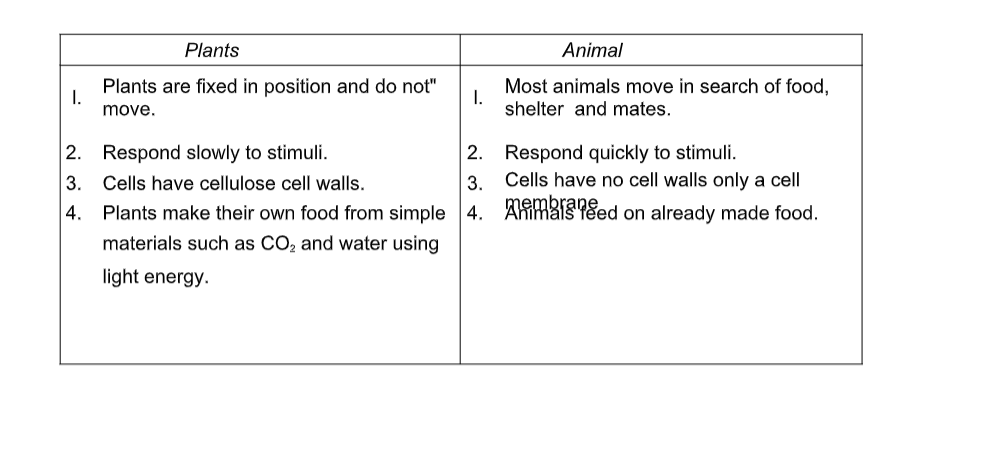
Classification I
Introduction
• Classification is putting organisms into groups
• Classification is based on the study of external characteristics of organisms
• It involves detailed observation of structure and functions of organisms
• Organisms with similar characteristics are put in one group
• Differences in structure are used to distinguish one group from another
• The magnifying lens is an instrument that assists in the observation of fine structure eg hairs by enlarging them
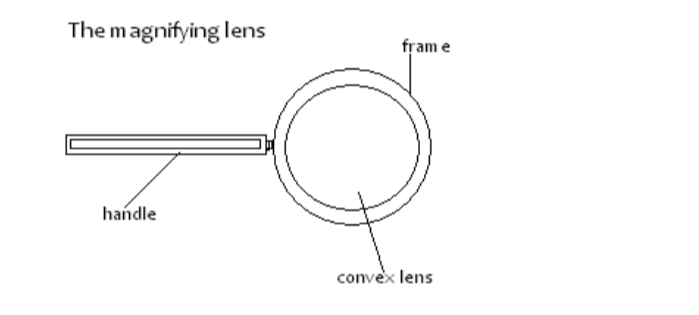
Using a Magnifying Lens
• A specimen is placed on the bench or held by hand,
• Then the magnifying lens is moved towards the eye until the object is dearly focused and an enlarged image is seen
The magnification can be worked out as follows:
Magnification = length of the drawing/
length of the specimen
Note: magnification has no units
Nececity/need for Classification
• To be able to identify organisms into their taxonomic groups
• To enable easier and systematic study of organisms
• To show evolutionary relationships in organisms
Major Units of Classification (Taxonomic Groups)
• Taxonomy is the study of the characteristics of organisms for the purpose of classifying them
• The groups are Taxa (singular Taxon)
The taxonomic groups include:
Species: This is the smallest unit of classification
Organisms of the same species resemble each other
The number of chromosomes in their cells is the same
Members of a species interbreed to produce fertile offspring
Genus (plural genera): A genus is made up of a number of species that share several characteristics
Members of a genus cannot interbreed and if they do, the offspring are infertile
Family: A family is made up of a number of genera that share several characteristics
Order: A number of families with common characteristics make an order
Class: Orders that share a number of characteristics make up a class
Phylum/Division: A number of classes with similar characteristics make up a phylum (plural phyla) in animals
In plants this is called a division
Kingdom: This is made up of several phyla (in animals) or divisions (in plants)
It is the largest taxonomic unit in classification
Kingdoms
Living organisms are classified into five kingdoms;
• Monera,
• Protoctista,
• Fungi,
• Plantae
• Animalia
Kingdom Fungi
• Some are unicellular while others are multicellular
• They have no chlorophyll
• Most are saprophytic eg yeasts, moulds and mushrooms
• A few are parasitic eg Puccinia graminae
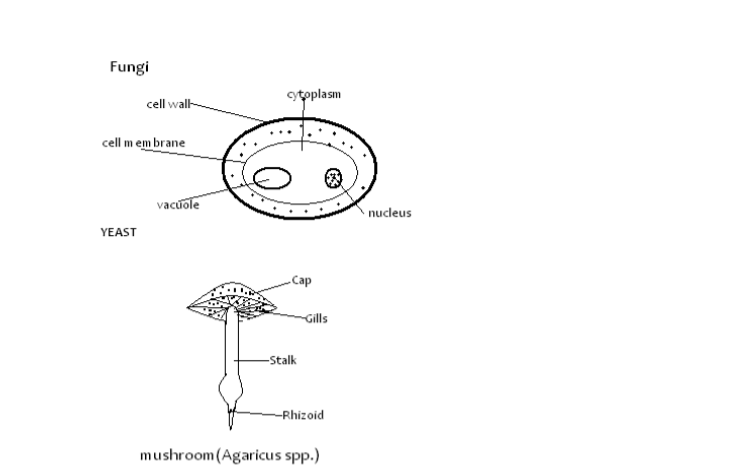
Kingdom Monera (Prokaryota)
• These are very small unicellular organisms
• They lack a nuclear membrane
• do not have any bound membrane organelles
• Hence the name Prokaryota
• They are mainly bacteria, eg Vibrio cholerae
Kingdom Protoctista
• They are unicellular organisms
• Their nucleus and organelles are surrounded by membranes (eukaryotic)
• They include algae, slime moulds – fungi-like and protozoa
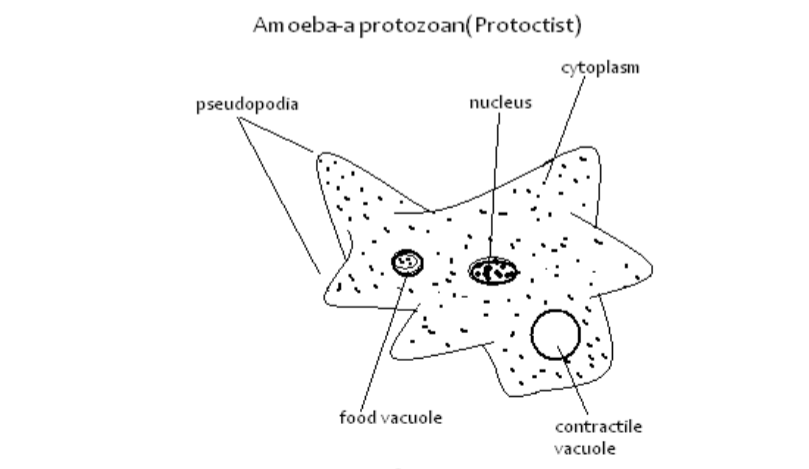

Kingdom Plantae
• They are all multicellular
• They contain chlorophyll and are all autotrophic
• They include; Bryophyta (mossplant), Pteridophyta (ferns) and Spermatophyta (seed bearing plants)
Kingdom Animalia
• These are all multicellular and heterotrophic
• Examples are annelida (earthworms), mollusca (snails),athropoda, chordata
• Example of Arthropods are ticks, butterflies
• Members of Chordata are fish, frogs and humans
External Features of Organisms
In plants we should look for:
• Spore capsule and rhizoids in moss plants
• Sori and fronds in ferns
• Stem, leaves, roots, flowers, fruits and seeds in plants
In animals, some important features to look for are:
• Segmentation, presence of limbs and, number of body parts, presence and number of antennae
These are found in phylum arthropoda:
• Visceral clefts, notochord, nerve tube, fur or hair, scales, fins, mammary glands, feathers and wings
• These are found in chordata
Binomial Nomenclature
• Organisms are known by their local names
• Scientists use scientific names to be able to communicate easily among themselves
• This method of naming uses two names, and is called Binomial nomenclature
• The first name is the name of the genus: (generic name) which starts with a capital letter
• The second name is the name of the species (specific name) which starts with a small letter
• The two names are underlined or written in italics
• Man belongs to the genus Homo, and the species, sapiens
• The scientific name of man is therefore Homo sapiens
• Maize belongs to the genus Zea, and the species mays
• The scientific name of maize is Zea mays
Practical Activities
• Use of Collecting Nets, Cutting Instruments and Hand Lens
• Forceps are used to collect crawling and slow moving animals
• Sweep nets are used to catch flying insects
• Cutting instrument like scapel is used to cut specimen e.g. making sections
• Hand lens is used to magnify small plants and animals
• Drawing of the magnified organism are made and the linear magnification of each calculated
Collection and Detailed Observation of Small Plants and Animals
e.g moss, ferns, bean
Look for the following:
• Moss plants: Rhizoids and spore capsules
• Fern plants: Rhizomes with adventitious roots; large leaves (fronds) with Sori (clusters of sporangia)
• Seed plants: Tree/shrub (woody) or non-woody (herbs) e.g. bean
• Root system – fibrous, adventitious and tap root
• Stem – position and length of interrnodes
• Type of leaves – simple or compound; arranged as alternate, opposite or whorled
• Flower – colour, number of parts, size and relative position of each:
• Fruits – freshy or dry; edible or not edible
• Seeds – monocotyledonous or dicotyledonous
Small animals e.g. earthworms, tick, grasshopper, butterfly, beetles
Observe these animals to see:
• Number of legs
• Presence or absence of wings
• Number of antennae
• Body covering
• Body parts
The Cell
Introduction
• The cell is the basic unit of an organism
• All living organisms are made up of cells
• Some organisms are made up of one cell and others are said to be multicellular
• Other organisms are made of many cells and are said to be multicellular
• Cells are too little to see with the naked eye
• They can only be seen with the aid of a microscope
The microscope
The microscope is used to magnify objects
Magnification
• The magnifying power is usually inscribed on the lens
• To find out how many times a specimen is magnified, the magnifying power of the objective lens is multiplied by that of the eye piece lens
• If the eye piece magnification lens is x10 and the objective lens is x4, the total magnification is x40
• Magnification has no units
• It should always have the multiplication sign
e.g.x40
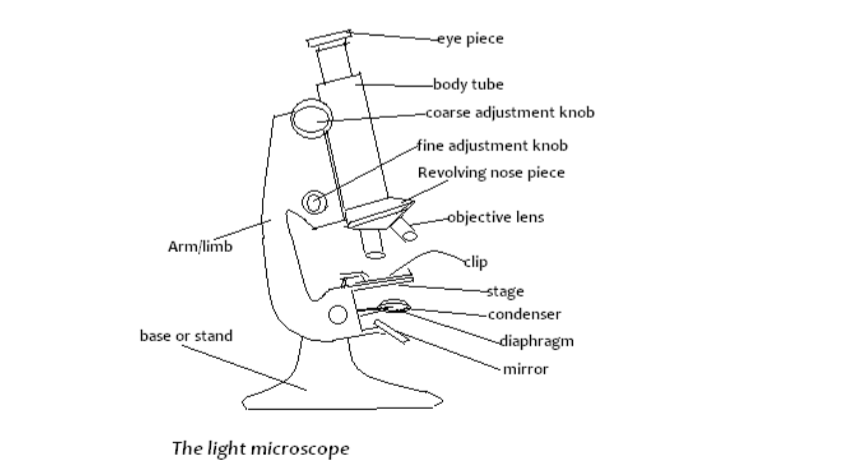
Microscope parts and their functions

To View the Object
• Turn the low power objective lens until it clicks into position
• Looking through the eye piece, ensure that enough light is passing through by adjusting the mirror
• This is indicated by a bright circular area known as the field of view
• Place the slide containing the specimen on stage and clip it into position
• Make sure that the specimen is in the centre of the field of view
• Using the coarse adjustment knob, bring the low power objective lens to the lowest point
• Turn the knob gently until the specimen comes into focus
• If finer details are required, use the fine adjustment knob
• When using high power objective always move the fine adjustment knob upwards
Care of a Microscope
• Great care should be taken when handling it
• Keep it away from the edge of the bench when using it
• Always hold it with both hands when moving it in the laboratory
• Clean the lenses with special lens cleaning paper
• Make sure that the low power objective clicks in position in line with eye piece lens before and after use
• Store the microscope in a dust-proof place free of moisture
Cell Structure as Seen Through the Light Microscope
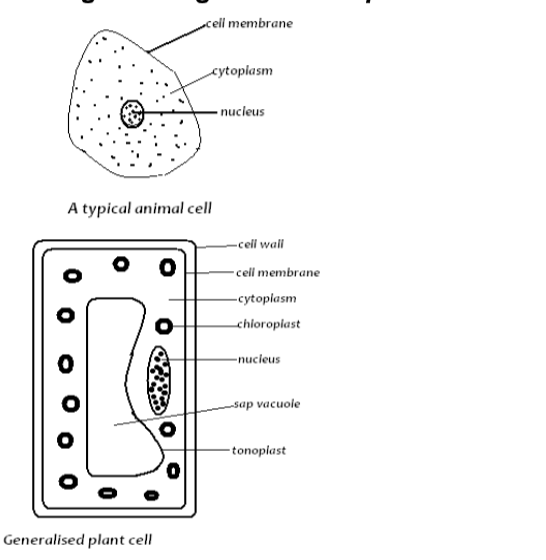
The cell as seen above has the following:
Cell membrane (Plasma membrane):
• This is a thin membrane enclosing cell contents
• It controls the movement of substances into and out of the cell
Cytoplasm:
• This is a jelly-like substance in which chemical processes are carried out
• Scattered all over the cytoplasm are small structures called organelles
• Like an animal cell, the plant cell has a cell membrane, cytoplasm and a nucleus
vacuole
• Plant cells have permanent, central vacuole
It contains cell sap where sugars and salts are stored
Cell wall:
• This is the outermost boundary of a plant cell
• It is made of cellulose
• Between the cells is a middle lamella made of calcium pectate
Chloroplasts;
• With special staining techniques it is possible to observe chloroplasts
• These are structures which contain chlorophyll, the green pigment responsible for trapping light for photosynthesis
The Electron Microscope (EM)
• Capable of magnifying up to 500,000 times
• The specimen is mounted in vacuum chamber through which an electron beam is directed
• The image is projected on to a photographic plate
• The major disadvantage of the electron microscope is that it cannot be used to observe living objects
• However, it provides a higher magnification and resolution (ability to see close points as separate) than the light microscope so that specimen can be observed in more detail
Cell Structure as Seen Through Electron Microscope
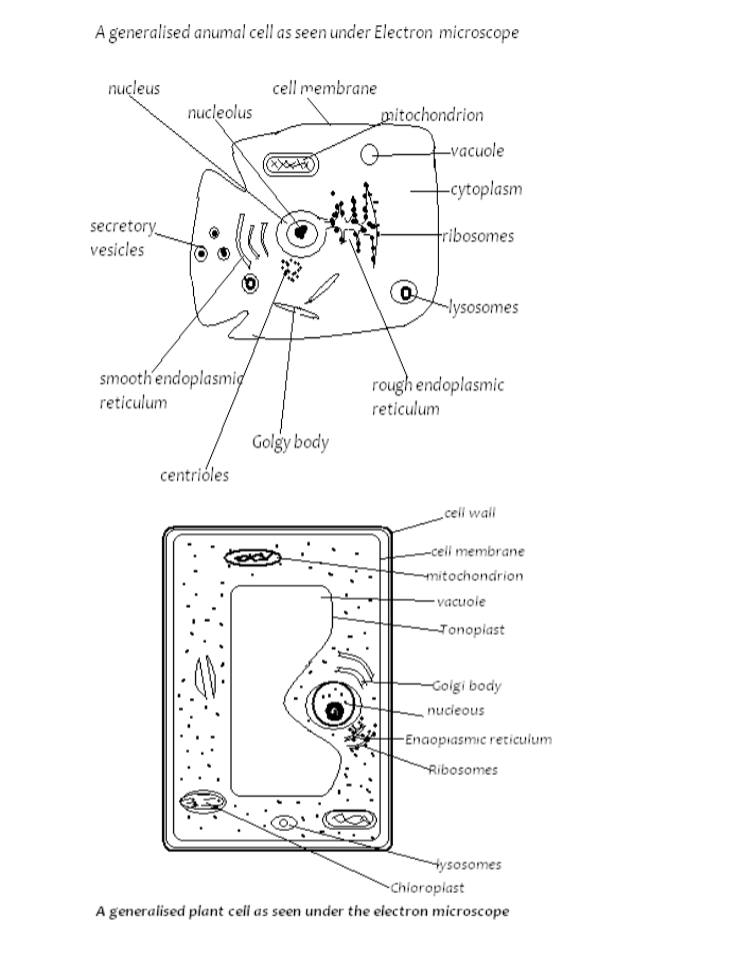
The Plasma Membrane
• Under the electron microscope, the plasma membrane is seen as a double layer
• This consists of a lipid layer sandwiched between two protein layers
• This arrangement is known as the unit membrane and the shows two lipid layers with proteins within
• Substances are transported across the membrane by active transport and diffusion

The Endoplasmic Reticulum (ER)
• This is a network of tubular structures extending throughout the cytoplasm of the cell
• It serves as a network of pathways through which materials are transported from one part of the cell to the other
• An ER encrusted with ribosomes it is referred to as rough endoplasmic reticulum
• An ER that lacks ribosomes is referred to as smooth endoplasmic reticulum
• The rough endoplasmic reticulum transports proteins while the smooth endoplasmic reticulum transports lipids
The Ribosomes
• These are small spherical structures attached to the ER
• They consist of protein and ribonucleic acid (RNA)
• They act as sites for the synthesis of proteins
Goigi Bodies
• Golgi bodies are thin, plate-like sacs arranged in stacks and distributed randomly in the cytoplasm
• Their function is packaging and transportation of glycol-proteins
• They also produce lysosomes
Mitochondria
• Each mitochondrion is a rod-shaped organelle
• Made up of a smooth outer membrane and a folded inner membrane
• The foldings of the inner membrane are called cristae
• They increase the surface area for respiration
• The inner compartments called the matrix
• Mitochondria are the sites of cellular respiration, where energy is produced
Lysosomes
• These are vesicles containing hydrolytic enzymes
• They are involved in the breakdown of micro-organisms, foreign macromolecules and damaged or worn-out cells and organelles
The Nucleus
• The nucle s is surrounded by a nuclear membrane which is a unit membrane
• The nuclear membrane has pores through which materials can move to the surrounding cytoplasm
• The nucleus contains proteins and nucleic acid deoxyribonucleic acid (DNA) and RNA
• The chromosomes are found in the nucleus
• They are the carriers of the genetic information of the cell
• The nucleolus is also located in the nucleus but it is only visible during the non-dividing phase of the cell
The Chloroplasts
• These are found only in photosynthetic cells
• Each chloroplast consists of an outer unit
membrane enclosing a series of interconnected membranes called lamellae
• At various points along their length the lamellae form stacks of disc like structures called grana
• The lamellae are embedded in a granular material called the stroma
• The chloroplasts are sites of photosynthesis
• The light reaction takes place in the lamellae while the dark reactions take place in the stroma
Comparison between animal cell and plant cell
Plant Cell Animal Cell
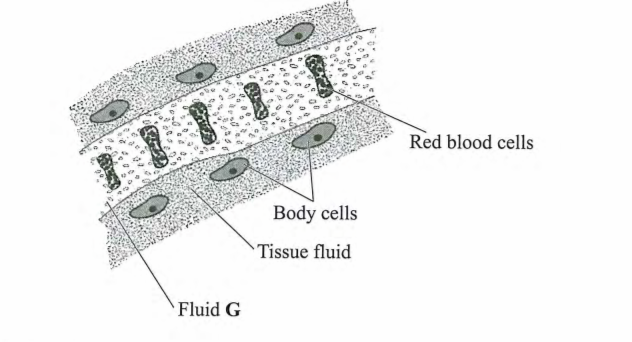

Cell Specialisation
Cells are specialised to perform different functions in both plants and animals
Example;
• Palisade cells have many chloroplasts for photosynthesis
• Root hair cells are long and thin to absorb water from the soil
• Red blood cells have haemoglobin which transports oxygen
• Sperm cells have a tail to swim to the egg
• Multicellular organisms cells that perform the same function are grouped together to form a tissue
• Each tissue is therefore made up of cells that are specialised to carry out a particular function
Animal Tissues- Examples of animal tissues
Plant Tissues
Organs
• An organ is made up of different tissues
• e.g the heart, lungs, kidneys and the brain in animals and roots, stems and leaves in plants
Organ systems
• Organs which work together form an organ system
• Digestive, excretory, nervous and circulatory in animals and transport and support system in plants
organism
• Different organ systems form an organism
Practical Activities
Observation and Identification of parts of a light microscope and their functions
• A light microscope is provided
• Various parts are identified and observed
• Drawing and labelling of the microscope is done
• Functions of the parts of the mircroscope are stated
• Calculations of total magnification done using the formula
• Eye piece lens maginification x objective lens maginification
Preparation and Observation of Temporary Slides of Plant Cells
• A piece of epidermis is made from the fleshy leaf of an onion bulb
It is placed on a microscope slide and a drop of water added
• A drop of iodine is added and a cover slip placed on top
• Observations are made, under low and medium power objective
• The cell wall and nucleus stain darker than other parts
• A labelled drawing is made
• The following are noted: Nucleus, cell wall, cytoplasm and cell membrane
Observation of permanent slides of animal cells
• Permanent slides of animal cells are obtained e.g, of cheek cells, nerve cells and muscle cells
• The slide is mounted on the microscope and observations made under low power and medium power objectives
• Labelled drawings of the cells are made
• A comparison between plant and animal cell is made
Observation and Estimation of Cell Size and Calculation of Magnification of Plant Cells
• Using the low power objective, a transparent ruler is placed on the stage of the microscope
• An estimation of the diameter of the field of view is made in millimeters
• This is converted into micrometres (1mm=1000u)
• A prepared slide of onion epidermal cells is mounted
• The cells across the centre of the field of view are counted from left and right and top to bottom
• The diameter of field of view is divided by the number of cells lying lengthwise to give an estimate of the length and width of each cell
Cell Physiology
Meaning of cell physiology
• The term physiology refers to the functions that occur in living organisms
• Cell physiology refers to the process through which substances move across the cell membrane
• Several physiological processes take place inside the cell e.g respiration
• Oxygen and glucose required enter the cell while carbon (IV) oxide and water produced leave the cell through the cell membrane
Structure and properties of cell membrane
• The cell membrane is the protective barrier that shelter cellular contents
• Movement of all substances into and out of the cells takes place across the cell membrane
• It is made up of protein and lipid molecules
• Lipid molecules have phosphate group attached to it on one end
• They are then referred to phospholipids
• The phospholipids are arranged to form a double layer
• The ends with phosphate group face outwards
• the proteins are scattered throughout the lipid double layer
• Some of these proteins act as carrier molecules that channel some material in and outside the cells
• The cell membrane allows certain molecules to pass through freely while others move through with difficulty and still others do not pass through at all
• This is selective permeability and the cell membrane is described as semi-permeable
Properties of cell membrane
Permeability
• The cell membrane is semi-permeable
• it allows small molecules that are soluble in lipid to pass through with more ease than water soluble molecules
• this is due to the presence of the phospholipids double layer
Polarlity
• The cell membrane has electrical charges across its surface
it has positive charged ions on the outside and negatively charged ions on the inside
this property contributes to electrical impulses sent along nerve cells
• Sensitivity to changes in temperature and pH
• Very high temperatures destroy the semi-permeability nature of the cell membrane because the proteins are denatured by extreme pH values have the same effect on the membrane permeability
• Physiological processes
• Some of the physiological processes include diffusion, osmosis and active transport
Diffusion
• Diffusion is the movement of molecules or ions from a region of high concentration to a region of low concentration aided by a concentration gradient
• diffusion continues to occur as long as there is a difference in concentration between two regions (concentration gradient)
• Stops when an equilibrium is reached i.e
, when the concentration of molecules is the same in both regions
• Diffusion is a process that occurs inside living organisms as well as the external environment
• Does not require energy
Factors Affecting Diffusion
Concentration Gradient
An increase in the concentration of molecules at one region results in a steeper concentration gradient which in turn increases the rate of diffusion
Temperature
High temperature increases kinetic energy of molecules
They move faster hence resulting in an increase in rate of diffusion, and vice versa
Size of Molecules or Ions
The smaller the size of molecules or ions, the faster their movement hence higher rate of diffusion
Density
The denser the molecules or ions diffusing, the slower the rate of diffusion, and vice versa
Medium
The medium through which diffusion occurs also affects diffusion of molecules or ions
For example, diffusion of molecules through gas and liquid media is faster than through a solid medium
Distance
This refers to the thickness or thinness of surface across which diffusion occurs
Rate of diffusion is faster when the distance is small i.e, thin surface
Surface Area to Volume Ratio
The larger the surface area to volume ratio, the faster the rate of diffusion
For example, in small organisms such as Amoeba the surface area to volume ratio, is greater hence faster diffusion than in larger organisms
Role of Diffusion in Living Organisms
Some processes that depend on diffusion include the following:
• Gaseous exchange: Movement of gases through respiratory surfaces is by diffusion
• Absorption of materials into cells Cells obtain raw materials and nutrients from the surrounding tissue fluid and blood through diffusion, e.g, glucose needed for respiration diffuses from blood and tissue fluid into cells
• Excretion: Removal of metabolic waste products like carbon (IV) oxide, and ammonia out of cells is by diffusion
• Absorption of the end-products of digestion from the intestines is by diffusion
Osmosis
• Osmosis is the movement of water molecules from a region of high water concentration to a region of low water concentration through a semi-permeable membrane
• Osmosis is a special type of diffusion that involves the movement of water molecules only and not solute molecules
• Osmosis takes place in cells across the cell membrane as well as across non-living membranes
• e.g cellophane or visking tubing which are also semi-permeable
• It is purely a physical process
•
Factors Affecting Osmosis
Size of solute molecules
Osmosis’ occurs only when solute molecules are too large to pass through a semi-permeable membrane
Concentration Gradient
Osmosis occurs when two solutions of unequal solute concentration are separated by a semi-permeable membrane
Temperature
High temperatures increase movement of water molecules hence influence osmosis
However, too high temperatures denature proteins in cell membrane and osmosis stops
Pressure
Increase in pressure affects movement of water molecules
As pressure increases inside a plant cell, osmosis decreases
Roles of Osmosis in Living Organisms
The following processes depend on osmosis in living organisms:
• Movement of water into cells from the surrounding tissue fluid and also from cell to cell
• Absorption of water from the soil and into the roots of plants
• Support in plants especially herbaceous ones, is provided by turgor pressure, which results from intake of water by osmosis
• Absorption of water from the alimentary canal in mammals
• Re-absorption of water in the kidney tubules
• Opening and closing stomata
Water Relations in Plant and Animal Cells
• The medium (solution) surrounding cells or organisms is described by the terms hypotonic, hypertonic and isotonic
• A solution whose solute concentration is more than that of the cell sap is said to be hypertonic
A cell placed in such a solution loses water to the surroundings by osmosis
• A solution whose solute concentration is less than that of the cell sap is said to be hypotonic
A cell placed in such a solution gains water from the surroundings by osmosis
• A solution which has the same solute concentration as the cell sap is said to be isotonic
When a cell is placed in such a solution there will be no net movement of water either into or out of the cell
Osmotic Pressure
• The term osmotic pressure describes the tendency of the solution with a high solute concentration to draw water into itself when it is separated from distilled water or dilute solution by a semi-permeable membrane
• Osmotic pressure is measured by an osmometer
• When plant cells are placed in distilled water or in a hypotonic solution, the osmotic pressure in the cells is higher than the osmotic pressure of the medium
• This causes the water to enter the cells by osmosis
• The water collects in the vacuole which increases in size
• As a result the cytoplasm is pushed outwards and it in turn presses the cell membrane next to the cell wall
• This builds up water pressure (hydrostatic pressure) inside the cell
• When the cell is stretched to the maximum, the cell wall prevents further entry of water into the cell
• Then the cell is said to be fully turgid
• The hydrostatic pressure developed is known as turgor pressure
Plasmolysis
• When a plant cell is placed in a hypertonic medium, it loses water by osmosis
• The osmotic pressure of the cell is lower than that of the medium
• The vacuole decreases in size and the cytoplasm shrinks as a result of which the cell membrane loses contact with the cell wall
• The cell becomes flaccid
The whole process is described as plasmolysis
• Incipient plasmolysis is when a cell membrane just begins to lose contact with the cell wall
• Plasmolysis can be reversed by placing the cell in distilled water or hypotonic solution
• However, full plasmolysis may not be reversed if cell stays in that state for long
Wilting
• The term wilting describes the drooping of leaves and stems of herbaceous plants after considerable amounts of water have been lost through transpiration
• It is observed in hot dry afternoons or in dry weather
• This is when the amount of water lost through transpiration exceeds the amount absorbed through the roots
• Individual cells lose turgor and become plasmolysed and the leaves and stems droop
• The condition is corrected at night when absorption of water by the roots continue while transpiration is absent
• Eventually, wilting plants may die if the soil water is not increased through rainfall or watering
Water Relations in Plants and Animals
Haemolysis
• Haemolysis is the bursting of cell membrane of red blood cells releasing their haemoglobin
• It occurs when red blood cells are placed in distilled water or hypotonic solution
• This is because the cell membrane does not resist further entry of water by osmosis after maximum water intake
Crenation
• Takes place when red blood cells are placed in hypertonic solution
• They lose water by osmosis, shrink and their shape gets distorted
• Animal cells have mechanisms that regulate their salt water balance (osmoregulation) to prevent above processes that lead to death of cells
• An Amoeba placed in distilled water, i.e
hypotonic solution, removes excess water using a contractile vacuole
• The rate of formation of contractile vacuoles increases
Active Transport
• Active transport is the movement of solutes such as
glucose, amino acids and mineral ions;
• From an area of their low concentration to an area of high concentration
• It is movement against a concentration gradient and therefore energy is required
• As such it only takes place in living organisms
• The energy needed comes from respiration
• Certain proteins in the cell surface membrane responsible for this movement are referred to as carrier proteins or channel proteins
• The shape of each type of carrier protein is specific to the type of substances conveyed through it
• It has been shown that the substance fits into a particular slot on the protein molecule,
• As the protein changes from one form of shape to another the substance is moved across and energy is expended
Factors Affecting Active Transport
Availability of oxygen
• Energy needed for active transport is provided through respiration
• An increase in the amount of oxygen results in a higher rate of respiration
• If a cell is deprived of oxygen active transport stops
Temperature
• Optimum temperature is required for respiration, hence for active transport
• Very high temperatures denature respiratory enzymes
• Very low temperatures inactivate enzymes too and active transport stops
Availability of carbohydrates
• Carbohydrates are the main substrates for respiration
• Increase in amount of carbohydrate results in more energy production during respiration and hence more active transport
• Lack of carbohydrates causes active transport to stop
Metabolic poisons
• Metabolic poisons e.g. cyanide inhibit respiration and stops active transport due to lack of energy
Role of Active Transport in Living Organisms
Processes requiring active transport:
• Absorption of mineral salts from the soil into plant roots
• Absorption of end products of digestion e.g. glucose and amino acids from the digestive tract into blood stream
• Excretion of metabolic products e.g.urea from the cells
• Re-absorption of useful substances and mineral salts back into blood capillaries from the kidney tubules
• Sodium-pump mechanism in nerve cells
• Re-absorption of useful materials from tissue fluid into the blood stream
Practical Activities
1.Experiment to Demonstrate Diffusion
• Various coloured substances such as: dyes, plant extracts and chemicals like potassium pennanganate are used
• Potassium manganate (VII) crystals are introduced to the bottom of a beaker filled with water using a glass tubing or drinking straw which is then removed
• Observations are made and the disappearance of the crystals and subsequent uniform colouring of water noted
2.Experiment to Demonstrate Osmosis Using a Visking Thbing
• A strip of visking tubing 8-10 cm is cut and tied at one end using strong thread
• About 2 ml of 25% sucrose solution is put inside and the other end tied with thread
• The tubing is washed under running water and then blotted to dry
• It is immersed in a beaker containing distilled water and left for at least one hour or overnight
• It will then be observed that the visking tubing has greatly increased in size and has become firm
• A control experiment can be set up using distilled water inside the visking tubing in place of sucrose solution
3.xperiment to Show Osmosis using Living Tissue
• Irish potato tubers are peeled and scooped out to make hollow space at the centre
• Sucrose solution is placed inside the hollow, and the potato tuber placed in a beaker or petri-dish with distilled water
A conttrol is set using a boiled potato
• Another one using distilled water inside hollow in place of sugar solution
• The experiment is left for 3 hours to 24 hours
4.Experiment to Demonstrate Turgor and Plasmolysis in Onion Epidermal Cells
• Two strips of onion epidermis are obtained
• One is placed on a slide with distilled water while the other is placed on a slide with 25% sucrose solution and a coverslip placed on top of each
• The mounted epidermis is observed under low power microscope and then left for 30 minutes
• After 30 minutes, observations are made again
The cells in distilled water have greatly enlarged
Cells in 25% sucrose have shrunk
Nutrition in Plants and Animals
Structure of the Leaf
External Structure
• The external structure of the leaf consists of a leaf stalk or petiole and a broad leaf blade or lamina
• The lamina has a main vein midrib from which smaller veins originate
• The outline of the leaf is the margin and the tip forms the apex
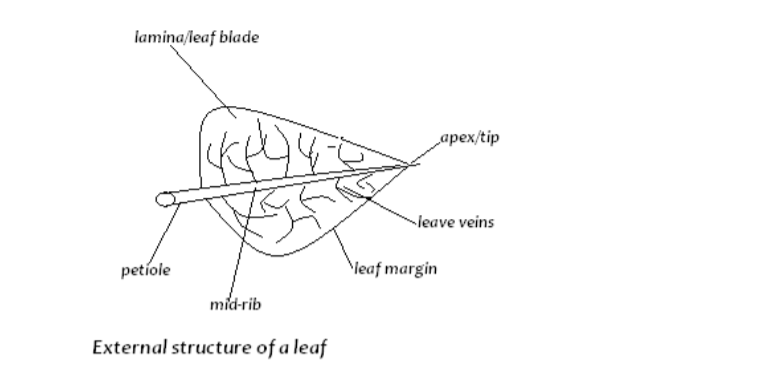
Internal Structure of the Leaf
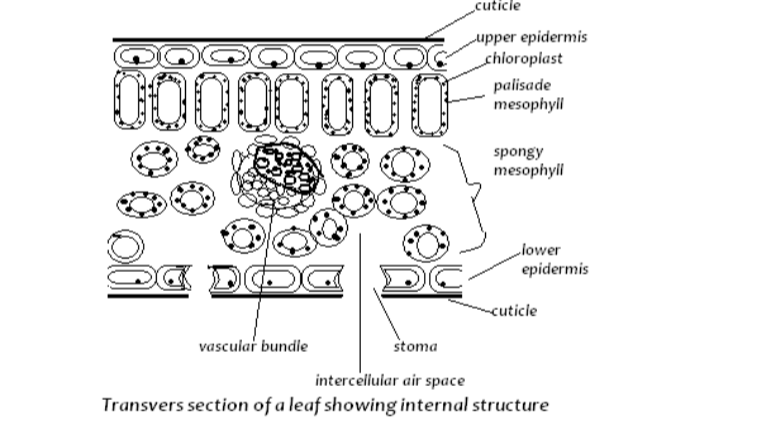
Epidermis
• This is the outer layer of cells, normally one cell thick
• It is found in both the upper and lower leaf surfaces
• The cells are arranged end to end
• The epidermis offers protection and maintains the shape of the leaf
• It is covered by a layer of cuticle which reduces evaporation
Leaf Mesophyll
Consists of the palisade layer, next to upper epidermis, and the spongy layer next to the lower epidermis
Palisade Mesophyll Layer
The cells are elongated and arranged close to each other leaving narrow air spaces
These contain numerous chloroplasts and are the main photosynthetic cells
In most plants, the chloroplast are distributed fairly uniformly throughout the cytoplasm
In certain plants growing in shaded habitats in dim light, most chloroplasts migrate to the upper region of the palisade cells in order to maximise absorption of the limited light available
Spongy Mesophyll Layer
• The cells are spherical in shape
• They are loosely arranged, with large intercellular spaces between them
• The spaces are air¬filled and are linked to the stomatal pores
• The spongy mesophyll cells have fewer chloroplasts than the palisade mesophyll cells
Vascular Bundles
• These are made up of the xylem and the phloem tissues
• The xylem transports water and mineral salts to the leaves
• The phloem transports food manufactured in the leaf to the other parts of the plant and from storage organs to other parts
Adaptations of Leaf for Photosynthesis
• Presence of veins with vascular bundles
Xylem vessels transport water for photosynthesis
• Phloem transports manufactured food from leaves to other parts of the plant
• Leaf lamina is thin to allow for penetration of light over short distance to reach photosynthetic cells
• Broad lamina provides a large surface area for absorption of light and carbon (IV) oxide
• Transparent cuticle and epidermal layer allow light to penetrate to mesophyll cells
• Palisade cells are close to the upper epidermis for maximum light absorption
• Presence of numerous chloroplasts in palisade mesophyll traps maximum light
• Chloroplast contain chlorophyll that traps light energy
• Spongy mesophyll layer has large intercellular air spaces allowing for gaseous exchange
• Presence of stomata for efficient gaseous exchange (entry of carbon (IV) oxide into leaf and exit of oxygen)
• Mosaic arrangement of leaves to ensure no overlapping of leaves hence every leaf is exposed to light
Structure and Function of Chloroplasts
• Chloroplasts are large organelles (5 um in diameter) found in the cytoplasm of green plant cells
• They are visible under the light microscope
• They contain chlorophyll, a green pigment and other carotenoids which are yellow, orange and red in colour
• Certain plants have red or purple leaves due to abundance of these other pigments
• Chlorophyll absorbs light energy and transforms it into chemical energy
• The other pigments absorb light but only to pass it onto chlorophyll

• The wall of chloroplast consists of an outer and an inner membrane
• The two make up the chloroplast envelop
• Inner membrane encloses a system of membranes called lamellae
• At intervals, the membranes form stacks of fluid filed sacs known as grana (singular granum)
• Chloroplast and other pigments are attached to the grana
• In between the lamellae is a gel-like stroma, that contains starch grains and lipid droplets
• Enzymes for the dark stage reaction (light independent stage) are embedded in the stroma
• Enzymes for the light dependent stage occur in the grana
Functions
• Absorption of light by chlorophyll and other pigments
• Light stage of photosynthesis occurs on the grana
(transformation of light energy to chemical energy
)
• Carbon fixation to form carbohydrate takes place in the stroma which has enzymes for dark stage of photosynthesis
Process of Photosynthesis
• Photosynthesis involves a series of chemical reactions, all of which take place inside chloroplasts
• A general equation for photosynthesis is:
Carbon (IV)Oxide+Water light energy—Glucose+Oxygen
chlorophyll
6CO2+6H2O light C6H12O+6O2
chlorophyll
• The reaction occurs in two main phases or stages
• The initial state requires light and it is called the light dependent stage or simply light stage
• It takes place on the lamellae surfaces
• Its products are used in the dark stage
• The dark stage does not require light although it occurs in the light and is called light independent stage
Light-Stage
• Two reactions take place that produce raw materials for the dark stage:
• Light energy splits the water molecules into hydrogen and oxygen
• This process is called photolysis
• The hydrogen is taken up by a hydrogen acceptor called Nicotinamide adenine dinucleotide phosphate (NADP) while oxygen is released as a by-product
2H2O(l) light energy4H+O2
photolysis
• Light energy strikes the chlorophyll molecules and sets in motion a series of reactions resulting in the production of a high energy molecule called adenosine triphophate (ATP)
Dark Stage
• This stage involves the fixation of carbon i.e
the reduction of carbon (IV) oxide by addition of hydrogen to form carbohydrate
• It uses the products formed during the light stage
• ATP
Carbon (IV) oxide + Hydrogen — Carbohydrates
• The synthesis of carbohydrates does not take place in a simple straight line reaction as shown in the equation above
• It involves a series of steps that constitute what is known as the Calvin cycle
• Carbon (IV) oxide is taken up by a compound described as a carbon (IV) oxide acceptor
• This is a 5-carbon compound known as ribulose biphosphate and a six carbon compound is formed which is unstable and splits into two three-carbon compounds
• Hydrogen from the light reaction is added to the three carbon compound using energy (ATP) from the light reaction
• The result is a three carbon (triose) sugar, (phosphoglycerate or PGA)
• This is the first product of photosynthesis
• Glucose, other sugars as well as starch are made from condensation of the triose sugar molecules
• The first product is a 3-carbon sugar which condenses to form glucose (6-C sugar)
• From glucose, sucrose and eventually starch is made
• Sucrose is the form in which carbohydrate is transported from the leaves to other parts of the plant
• Starch is the storage product
• Other substances like oils and proteins are made from sugars
• This involves incorporation of other elements e.g. nitrogen, phosphorus and sulphur
Factors Influencing Photosynthesis
• Certain factors must be provided for before photosynthesis can take place
• The rate or amount of photosynthesis is also influenced by the quantity or quality of these same factors
Carbon(IV) Oxide Concentration
• Carbon (IV) oxide is one of the raw materials for photosynthesis
• No starch is formed when leaves are enclosed in an atmosphere without carbon (IV) oxide
• The concentration of carbon (IV) oxide in the atmosphere remains fairly constant at about 0.03% by volume
• However, it is possible to vary the carbon (IV) oxide concentration under experimental conditions
• Increasing the carbon (IV) oxide concentration up to 0.1 % increases the rate of photosynthesis
• Further increase reduces the rate
Light Intensity
• Light supplies the energy for photosynthesis
• Plants kept in the dark do not form starch
• Generally, increase in light intensity up to a certain optimum, increases the rate of photosynthesis
• The optimum depends on the habitat of the plant
• Plants that grow in shady places have a lower optimum than those that grow in sunny places
Water
• Water is necessary as a raw material for photosynthesis
• The amount of water available greatly affects the rate of photosynthesis
• The more water available, the more the photosynthetic rate, hence amount of food made
• Effect of water on photosynthesis can only be inferred from the yield of crops
• It is the main determinant of yield (limiting factor in the tropics)
Temperature
• The reactions involved in photosynthesis are catalysed by a series of enzymes
• A suitable temperature is therefore necessary
• The optimum temperature for photosynthesis in most plants is around 30″C
• This depends on the natural habitat of the plant
• Some plants in temperate regions have 20°C as their optimum while others in the tropics have 45°C as their optimum temperature
• The rate of photosynthesis decreases with a decrease in temperature below the optimum
• In most plants, photosynthesis stops when temperatures approach O°C although some arctic plant species can photosynthesise at -2°C or even -3°C
• Likewise, increase in temperature above the optimum decreases the rate and finally the reactions stop at temperatures above 40°c due to enzyme denaturation
• However, certain algae that live in hot springs e.g. Oscilatoria can photosynthesise at 75°C
Chlorophyll
• Chlorophyll traps or harnesses the energy from light
• Leaves without chlorophyll do not form starch
Chemical Compounds Which Constitute Living Organisms
• All matter is made up of chemical elements, each of which exists in the form of smaller units called atoms
• Some of the elements occur in large amounts in living things
• These include carbon, oxygen, hydrogen, nitrogen, sulphur and phosphorus
• Elements combine together to form compounds
• Some of these compounds are organic
• Organic compounds contain atoms of carbon combined with hydrogen and they are usually complex
• Other compounds are inorganic
• Most inorganic compounds do not contain carbon and hydrogen and they are usually less complex
• Cells contain hundreds of different classes of organic compounds
• However, there are four classes of organic compounds found in all cells
• These are: carbohydrates, lipids, proteins and nucleic acids
Carbohydrates
• Carbohydrates are compounds of carbon, hydrogen and oxygen
• Hydrogen and oxygen occur in the ratio of 2: 1 as in water
• Carbohydrates are classified into three main groups: monosaccharides, disaccharides and polysaccharides
Monosaccharides
• These are simple sugars
• The carbon atoms in these sugars form a chain to which hydrogen and oxygen atoms are attached
• Monosaccharides are classified according to the number of carbon atoms they possess
• The most common monosaccharides are:
[ad_2]
Source link
Comments
The Kenyan Digest Team

You may like
Rayvanny officially leaves Diamond’s WCB Wasafi after 6 years
Raila Odinga is the most popular presidential candidate, a survey released by Infotrak
Newly-crowned Kenyan Wimbledon champion Angella Okutoyi would like to play against American star Serena Williams

The Mombasa High Court has ordered IEBC to clear Sonko to run for the Mombasa governorship.

A new born baby was pulled out of latrine in Mururi.

Kenyan Rapper Colonel Mustafa has leveled fresh accusations against his ex-girlfriend Katoto.
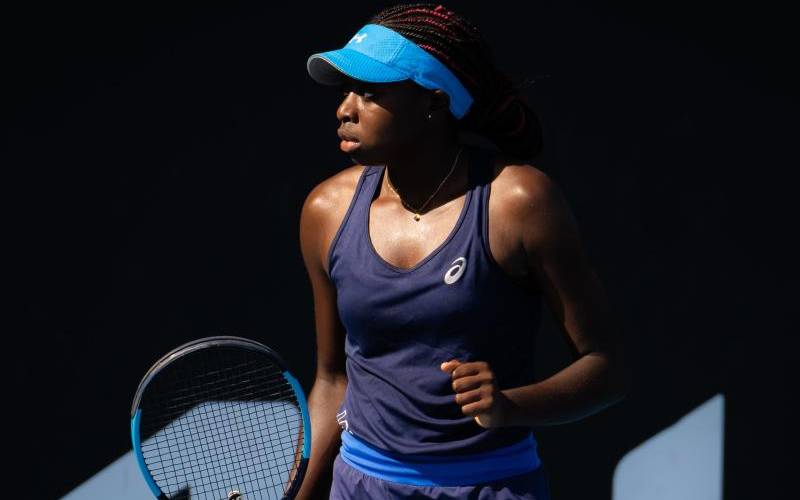
Okutoyi and Nijkamp qualify for Wimbledon Open final
Fans will have to brace themselves for a sober 90 minutes, the Gulf Arab state announces.
